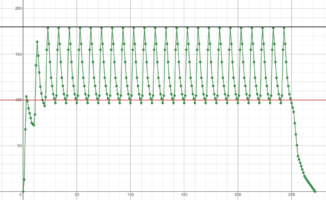In order to find the exact area under this curve, I need an equation so that I can use the formula. I was wondering if there was a way to create an equation that follows the entire graph curve or even just multiple equations covering different parts.
I need to calculate the total area under the spike shaped graph lines, above the red line if that makes sense. However a start would just be being able to find an equation.
Any help would be appreciated.

I need to calculate the total area under the spike shaped graph lines, above the red line if that makes sense. However a start would just be being able to find an equation.
Any help would be appreciated.

